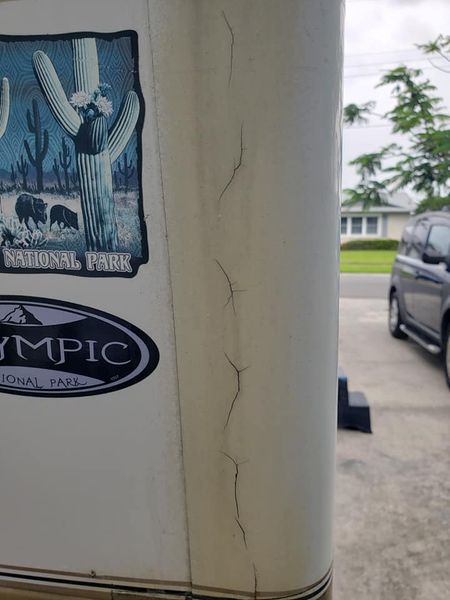The bumps that are on the aluminum sides of some Lazy Dazes, that people call bumps, rust, or corrosion is oxidation (also often referred to as electrolysis).
It is caused when water/moisture gets between the aluminum and the coating/paint on the outside of the aluminum.
This happens because the paint/coating becomes permeable over time as the aluminum flexes and is stressed. It has been seen on LDs never exposed to sea air or chemicals used on snowy roads, it has been seen on LDs just a few years old, but most often it is on older LDs.
Having one or even many of these does not mean that water got into your LD wall - that problem comes from other causes.
Once electrolysis starts, it will continue even if there is no more moisture/water (eg in a desert inside a garage), and the bumps just get worse.
To fix the bumps the basic steps (details below) are to sand the the area down to bare metal. The area needs to be cleaned as a prep to the next step. Then any damage to the aluminum needs to be fixed. Then just primer and paint.
Airlines use Scotch-Brite Surface Conditioning Discs (a drill attachment) to sand the affected area. Make sure you get all the affected area (go a little bigger than the bumps until you see good paint-aluminum adhesion).
We found conditioning discs at Home Depot.
The material inside the bump typically crumbles - like chalk would.
Once you have the area sanded you will see different situations.
For a newer bump you will see the aluminum looks fully intact (no holes or indentation).
You may see no holes but an indentation, this needs to be patched back up to level (details below).
If the bumps have been there a while (larger) you will likely see a hole once you sand it down. The hole can be the size of a straight pin body or larger.
The oxidation leaves behind a fine powder. If you have a hole, that powder will be in the hole and as part of the cleaning you need to use compressed air (canned air works fine) to blow out any dust you can so the repair material will stick. Throughly blow it out - past where you think you have it all out (speaking from experience here).
You can check if the hole let water into the wall - depends a lot on your climate (rain, humidity) and size of the hole that penetrated fully through the aluminum.
If the hole is very tiny, it is unlikely water got into the wall but the only way to check is from the inside.
If the hole is larger (I have not seen any larger than 1/16” but of course they could get larger), you can check by poking inside the hole to check for wood rot. I highly suggest knowing how it feels to poke (with metal) new pine wood (soft wood and softer than the older wood in your LD) so you know if the wood inside the siding hole is rotted or not. But personally if I felt wood rot I would address that from inside the LD unless I was taking that siding completely off for other reasons.
To repair the damaged aluminum - an indentation or a hole - even a tiny one,
Use JB Weld brand epoxy - this is what commercial aircraft uses. There is a lot of JBWeld, make sure you choose one that clearly say it works on aluminum (stated on back of package typically).
Prep as the JB Weld says to. The JB Weld we used hardened quickly but it also sanded level very easily. It was also easy to scrap level with a plastic putty knife which almost completely eliminated any need to sand.
When that cures, primer and paint - most LD owners use automotive primer paint.
Do not leave the aluminum bare - this will just create more oxidation.















